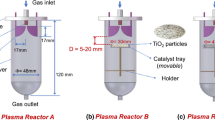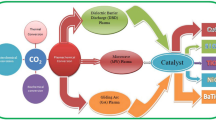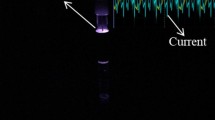Abstract
In situ FTIR transmission experiments for \(\hbox {CO}_2\) and \(\hbox {CO}_2\)–\(\hbox {CH}_4\) plasma were performed for a fundamental study of surface plasma interaction with cerium oxide (\(\hbox {CeO}_2\)) as catalytic surface. Utilizing a DC glow discharge plasma reactor at low pressure, it was observed that \(\hbox {CO}_2\) gas adsorbs in the surface forming tridentate carbonates and hydrogen carbonates. When \(\hbox {CO}_2\)–\(\hbox {CH}_4\) plasma is ignited, formate species were formed while carbonate species disappeared from the surface. The \(\hbox {CeO}_2\) pellet has also been placed downstream the plasma in order to observe the role of the gas composition at the exit of \(\hbox {CO}_2\)–\(\hbox {CH}_4\) plasma on \(\hbox {CeO}_2\) without any heating or strong electric field. In addition, the effect of water was investigated in several surface phenomena. OH groups play an important role in the reaction with tridentate carbonates to generate formates under plasma. The gas phase chemistry of the \(\hbox {CO}_2\)–\(\hbox {CH}_4\) plasma used here has been described in details in the part I of this work. The conclusions drawn on the gas phase contribute to the understanding of the observed phenomena on \(\hbox {CeO}_2\). These results enlighten the complex mechanisms occurring during \(\hbox {CO}_2\)–\(\hbox {CH}_4\) plasma reactions on surfaces that could help in the improvement of \(\hbox {CO}_2\) recycling.
























Similar content being viewed by others
Data Availability
All data presented in this work will be made available upon request to the corresponding author.
References
John M (2019) Christensen and Anne Olhoff. United Nations Environment Programme, Lessons from a decade of emissions gap assessments
Chung Wei-Chieh, Chang Moo-Been (2016) Review of catalysis and plasma performance on dry reforming of \(\text{ CH}_4\) and possible synergistic effects. Renew Sustain Energy Rev 62:13–31. https://doi.org/10.1016/j.rser.2016.04.007
Vakili Reza et al (2020) Plasma-assisted catalytic dry reforming of methane (DRM) over metal-organic frameworks (MOFs)-based catalysts. Appl Catal B 260:118195. https://doi.org/10.1016/j.apcatb.2019.118195
Sheng Zunrong et al (2020) Plasma-chemical promotion of catalysis for \(\text{ CH}_{4}\) dry reforming: unveiling plasmaenabled reaction mechanisms. Phys Chem Chem Phys 22.34:19349–19358
Salcedo Agustín, Irigoyen Beatriz (2020) Unraveling the origin of ceria activity in water-gas shift by first-principles microkinetic modeling. J Phys Chem C 124.14:7823–7834. https://doi.org/10.1021/acs.jpcc.0c00229
Schilling Christian, Hess Christian (2018) Elucidating the role of support oxygen in the water-gas shift reaction over ceria-supported gold catalysts using operando spectroscopy. ACS Catal 9.2:1159–1171. https://doi.org/10.1021/acscatal.8b04536
Schilling Christian, Hess Christian (2018) Elucidating the role of support oxygen in the water-gas shift reaction over ceria-supported gold catalysts using operando spectroscopy. ACS Catal 9.2:1159–1171. https://doi.org/10.1021/acscatal.8b04536
Hernández-Giménez Ana M, Lozano-Castelló Dolores, Bueno-López Agustín (2014) Effect of \(\text{ CO}_2\), \(\text{ H}_{2}\text{ O }\) and \(\text{ SO}_2\) in the ceria-catalyzed combustion of soot under simulated diesel exhaust conditions. Appl Catal B 148–149:406–414. https://doi.org/10.1016/j.apcatb.2013.11.029
Sakthiraj K, Karthikeyan B (2019) Synthesis and characterization of cerium oxide nanoparticles using different solvents for electrochemical applications. Appl Phys A 126.1. https://doi.org/10.1007/s00339-019-3227-z
Mullins David R (2015) The surface chemistry of cerium oxide. Surf Sci Rep 70.1:42–85. https://doi.org/10.1016/j.surfrep.2014.12.001
Baratte E et al. \(\text{ CO}_2/\text{CH}_4\) plasma glow discharge. Part I: experimental and numerical study of the reaction pathways. In: Plasma sources science and technology (“submitted”)
Silva AF et al (2020) A reaction mechanism for vibrationally-cold low-pressure \(\text{ CO}_2\) plasmas. Plasma Sources Sci Technol 29.12:125020. https://doi.org/10.1088/1361-6595/abc818
Rǎduţoiu N, Teodorescu CM (2013) Satellites in Ce 3d X-ray photoelectron spectroscopy of ceria. Dig J Nanomater Biostruct 8.4:1535–1549
Vayssilov Georgi N et al (2011) Reassignment of the vibrational spectra of carbonates, formates, and related surface species on ceria: a combined density functional and infrared spectroscopy investigation. J Phys Chem C 115.47:23435–23454. https://doi.org/10.1021/jp208050a
Chen Fendy et al (2012) A DFT+U study of the lattice oxygen reactivity toward direct CO oxidation on the \(\text{ CeO}_{2}\) (111) and (110) surfaces. Phys Chem Chem Phys 14.48:16573–16580
Morillo-Candas AS, Guerra V, Guaitella O (2020) Time evolution of the dissociation fraction in rf \(\text{ CO}_2\) plasmas: impact and nature of back-reaction mechanisms. J Phys Chem C 124.32, pp 17459–17475. https://doi.org/10.1021/acs.jpcc.0c03354
Booth J-P et al (2015) Gas temperature measurements in oxygen plasmas by high-resolution two-photon absorption laser-induced fluorescence. J Instrum 10.11:C11003–C11003. https://doi.org/10.1088/1748-0221/10/11/c11003
Booth JP et al (2019) Oxygen (3P) atom recombination on a Pyrex surface in an \(\text{ O}_2\) plasma. Plasma Sources Sci Technol 28.5:055005. https://doi.org/10.1088/1361-6595/ab13e8
Ferreira-Aparicio P et al (2000) Mechanistic aspects of the dry reforming of methane over ruthenium catalysts. Appl Catal A 202.2:183–196. https://doi.org/10.1016/s0926-860x(00)00525-1
Winter Lea R et al (2020) Identifying surface reaction intermediates in plasma catalytic ammonia synthesis. ACS Catal 10.24:14763–14774. https://doi.org/10.1021/acscatal.0c03166
Mikhail Maria et al (2020) Electrocatalytic behaviour of \(\text{ CeZrO}_x\)-supported Ni catalysts in plasma assisted \(\text{ CO}_2\) methanation. Catal Sci Technol 10.14:4532–4543. https://doi.org/10.1039/d0cy00312c
Agarwal S, Lefferts L, Mojet BL. Ceria nanocatalysts : shape dependent reactivity and formation of OH. In: (2012), pp 1–12. https://doi.org/10.1002/cctc.201200491
Agarwal Shilpa et al (2013) Exposed surfaces on shape-controlled ceria nanoparticles revealed through AC-TEM and water-gas shift reactivity. Chemsuschem 6.10:1898–1906. https://doi.org/10.1002/cssc.201300651
Badri Ahmed, Binet Claude, Lavalley Jean-Claude (1996) An FTIR study of surface ceria hydroxy groups during a redox process with \(\text{ H}_2\). J Chem Soc, Faraday Trans 92.23:4669. https://doi.org/10.1039/ft9969204669
Mino Lorenzo, Spoto Giuseppe, Ferrari Anna Maria (2014) \(\text{ CO}_2\) capture by \(\text{ TiO}_2\) anatase surfaces: a combined DFT and FTIR study. J Phys Chem C 118.43:25016–25026. https://doi.org/10.1021/jp507443k
Sorescu Dan C, Al-Saidi Wissam A, Jordan Kenneth D (2011) \(\text{ CO}_2\) adsorption on \(\text{ TiO}_2\) (101) anatase: a dispersion-corrected density functional theory study. J Chem Phys 135.12:124701. https://doi.org/10.1063/1.3638181
Parkyns ND (1969) The surface properties of metal oxides. Part II: an infrared study of the adsorption of carbon dioxide on \(\gamma \)-alumina. J Chem Soc A 0.0, 410–417. https://doi.org/10.1039/j19690000410
Li Can et al (1990) Spectroscopic identification of adsorbed species derived from adsorption and decomposition of formic acid, methanol, and formaldehyde on cerium oxide. J Catal 125.2:445–455. https://doi.org/10.1016/0021-9517(90)90317-d
Mudiyanselage Kumudu et al (2015) Isolation and characterization of formates on \(\text{ CeO}_{x}-\text{ Cu}_y\text{ O }/\text{Cu }\)(1 1 1). Catal Today 240:190–200. https://doi.org/10.1016/j.cattod.2014.06.001
Rousseau Séverine et al (2010) Investigation of methanol oxidation over Au/catalysts using operando IR spectroscopy: determination of the active sites, intermediate/spectator species, and reaction mechanism. J Am Chem Soc 132.31:10832–10841. https://doi.org/10.1021/ja1028809
Lustemberg PG et al (2015) Insights into the nature of formate species in the decomposition and reaction of methanol over cerium oxide surfaces: a combined infrared spectroscopy and density functional theory study. J Phys Chem C 119.37:21452–21464. https://doi.org/10.1021/acs.jpcc.5b05070
Sagar Vikram Tatiparthi, Pintar Albin (2020) Enhanced surface properties of \(\text{ CeO}_2\) by MnO doping and their role in mechanism of methane dry reforming deduced by means of in-situ DRIFTS. Appl Catal A 599:117603. https://doi.org/10.1016/j.apcata.2020.117603
Li C, et al (1989) Adsorption of carbon monoxide and carbon dioxide on cerium oxide studied by Fouriertransform infrared spectroscopy. Part 2.—formation of formate species on partially reduced \(\text{ CeO}_{2}\) at room temperature. J Chem Soc Faraday Trans 1: Phys Chem Condens Phases 85(6):1451. https://doi.org/10.1039/f19898501451
Agarwal Shilpa, Lefferts Leon, Mojet Barbara L (2012) Ceria nanocatalysts: shape dependent reactivity and formation of OH. ChemCatChem 5.2:479–489. https://doi.org/10.1002/cctc.201200491
Li C, et al (1989) Carbon monoxide and carbon dioxide adsorption on cerium oxide studied by Fourier transform infrared spectroscopy . Part 1.-Formation of carbonate species on dehydroxylated \(\text{ CeO}_{2}\), at room temperature. J Chem Soc Faraday Trans 85(6):1451–1461
Shido T, Iwasawa Y (1993) Reactant-promoted reaction mechanism for water-gas shift reaction on Rh-doped \(\text{ CeO}_{2}\). J Catal 141.1:71–81. https://doi.org/10.1006/jcat.1993.1119
Liu Junlong et al (2007) Methanol selective oxidation to methyl formate over \(\text{ ReO}_x/\text{CeO}_2\) catalysts. Catal Lett 120.3–4:274–280. https://doi.org/10.1007/s10562-007-9280-9
Luo Lingyiqian et al (2020) Investigate interactions of water with mesoporous ceria using in situ VT-DRIFTS. Surf Sci 691:121486. https://doi.org/10.1016/j.susc.2019.121486
Binet Claude, Daturi Marco, Lavalley Jean-Claude (1999) IR study of polycrystalline ceria properties in oxidised and reduced states. Catal Today 50.2:207–225. https://doi.org/10.1016/s0920-5861(98)00504-5
Li C et al (1989) Adsorption of carbon monoxide and carbon dioxide on cerium oxide studied by Fourier transform infrared spectroscopy. Part 2.—formation of formate species on partially reduced \(\text{ CeO}_2\) at room temperature. J Chem Soc Faraday Trans 1: Phys Chem Condens Phases 85(6): 1451. https://doi.org/10.1039/f19898501451
Hussain MM, Rahman MM, Asiri AM (2016) Efficient 2-nitrophenol chemical sensor development based on \(\text{ Ce}_2\text{ O}_3\) nanoparticles decorated cnt nanocomposites for environmental safety. PLoS ONE 11(12):1–17. ISSN:19326203. https://doi.org/10.1371/journal.pone.0166265
Atoji M (1967) Magnetic and crystal structures of \(\text{ CeC}_{2}\), \(\text{ PrC}_{2}\), \(\text{ NdC}_{2}\), \(\text{ TbC}_{2}\), and \(\text{ HoC}_{2}\) at low temperatures. J Chem Phys 46.5:1891–1901. https://doi.org/10.1063/1.1840950
Bosak A, et al (2007) Elasticity of single-crystalline graphite: inelastic x-ray scattering study. Phys Rev B 75(15). https://doi.org/10.1103/physrevb.75.153408
Pham MH et al (2011) Activation of methane and carbon dioxide in a dielectric-barrier discharge-plasma reactor to produce hydrocarbons-Influence of \(\text{ La}_{2}\text{ O}_{3}/\gamma -\text{ Al}_{2}\text{ O}_{3}\) catalyst. Catal Today 171.1:67–71. https://doi.org/10.1016/j.cattod.2011.03.015
Pinhão NR, Janeco A, Branco JB (2011) Influence of helium on the conversion of methane and carbon dioxide in a dielectric barrier discharge. Plasma Chem Plasma Process 31.3:427–439. https://doi.org/10.1007/s11090-011-9294-3
Zhou LM et al (1998) Nonequilibrium plasma reforming of greenhouse gases to synthesis gas. Energy Fuels 12.6:1191–1199. https://doi.org/10.1021/ef980044h
Di Hu et al (2018) Carbon dioxide reforming of methane over nickel catalysts supported on \(\text{ TiO}_{2}\) (001) nanosheets. Int J Hydrog Energy 43.46:21345–21354. https://doi.org/10.1016/j.ijhydene.2018.09.188
Acknowledgements
This project has received funding from the European Union’s Horizon 2020 research and innovation programme under the Marie Skłodowska-Curie grant agreement No. 813393. This work was partially supported by the Agence Nationale de la Recherche (ANR, Investissement d’Avenir program), under project ANR-18-EURE-0014. This work was partially supported by the Portuguese FCT-Fundação para a Ciência e a Tecnologia, under projects UIDB/50010/2020, UIDP/50010/2020, PTDC/FIS-PLA/1616/2021, EXPL/FIS-PLA/0076/2021.
Funding
(details of any funding received) This project has received funding from the European Union’s Horizon 2020 research and innovation programme under the Marie Skłodowska-Curie grant agreement No. 813393. This work was partially supported by the Agence Nationale de la Recherche (ANR, Investissement d’Avenir program), under project ANR-18-EURE-0014. This work was partially supported by the Portuguese FCT-Fundação para a Ciência e a Tecnologia, under projects UIDB/50010/2020, UIDP/50010/2020, PTDC/FIS-PLA/1616/2021, EXPL/FIS-PLA/0076/2021.
Author information
Authors and Affiliations
Contributions
(applicable for submissions with multiple authors) C.A.G.S. did the measurement and wrote the paper, E.B. contributed to experiment, T.S. and V.G. developed the code, V.I.P. discussed the chemistry, O.G. supervised the work. All authors reviewed the manuscript.
Corresponding author
Ethics declarations
Conflict of interest
(always applicable and includes interests of a financial or personal nature) No, I declare that the authors have no competing interests as defined by Springer, or other interests that might be perceived to influence the results and/or discussion reported in this paper. The authors declare no competing interests.
Ethical Approval
(applicable for both human and/ or animal studies. Ethical committees, Internal Review Boards and guidelines followed must be named. When applicable, additional headings with statements on consent to participate and consent to publish are also required) This declaration is not applicable for the work proposed in this paper.
Financial Interest or Non-financial
All authors certify that they have no affiliations with or involvement in any organization or entity with any financial interest or non-financial interest in the subject matter or materials discussed in this manuscript.
Additional information
Publisher's Note
Springer Nature remains neutral with regard to jurisdictional claims in published maps and institutional affiliations.
Supplementary Information
Below is the link to the electronic supplementary material.
Rights and permissions
Springer Nature or its licensor (e.g. a society or other partner) holds exclusive rights to this article under a publishing agreement with the author(s) or other rightsholder(s); author self-archiving of the accepted manuscript version of this article is solely governed by the terms of such publishing agreement and applicable law.
About this article
Cite this article
Garcia-Soto, C.A., Baratte, E., Silva, T. et al. CO2/CH4 Glow Discharge Plasma. Part II: Study of Plasma Catalysis Interaction Mechanisms on CeO2. Plasma Chem Plasma Process (2023). https://doi.org/10.1007/s11090-023-10419-7
Received:
Accepted:
Published:
DOI: https://doi.org/10.1007/s11090-023-10419-7




